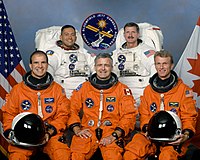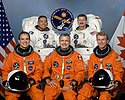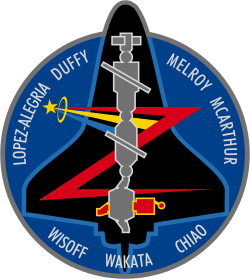STS-97
| Missionsemblem | |||||
|---|---|---|---|---|---|
 | |||||
| Missionsstatistik | |||||
| Missionsnavn: | STS-97 | ||||
| Rumagentur: | NASA | ||||
| Rumfærge: | Endeavour (15) | ||||
| Affyringsrampe: | LC-39A (KSC) | ||||
| Opsendelse: | 30. november 2000 | ||||
| Landing: | 11. december 2000 | ||||
| Landet på: | Kennedy Space Center | ||||
| Varighed: | 10 døgn og 19 timer | ||||
| Foto af besætningen | |||||
 | |||||
| Navigation | |||||
| |||||

Denne artikel handler om en mission i rumfærge-programmet. For informationer om programmet se rumfærge-programmet.
STS-97 (Space Transportation System-97) var rumfærgen Endeavours 15. mission, opsendt d. 30. november 2000 og vendte tilbage d. 11. december 2000.
Hovedformålet med missionen var at montere det medbragte, P6 Truss, første del af solpanel-systemet til Den Internationale Rumstation.
Tre rumvandringer blev fuldført på missionen der varede i næsten 11 døgn.
Besætning

 Brent Jett (kaptajn)
Brent Jett (kaptajn)
 Michael Bloomfield (pilot)
Michael Bloomfield (pilot)
 Joseph Tanner (1. missionsspecialist)
Joseph Tanner (1. missionsspecialist)
 Marc Garneau (2. missionsspecialist) (CSA)
Marc Garneau (2. missionsspecialist) (CSA)
 Carlos Noriega (3. missionsspecialist)
Carlos Noriega (3. missionsspecialist)
Missionen
P6 solpanel
Rumvandring for opsætning af solpanel
Rumstationen efter Endeavours besøg
Det var en af missionerne der skulle udbygge Den Internationale Rumstation Assembly Mission 4A.
Andre ISS udbygnings-missioner: STS-88, STS-92, STS-98, STS-100, STS-102, STS-104, STS-110, STS-111, STS-112, STS-113, STS-114, STS-115, STS-116, STS-117, STS-118, STS-120, STS-122, STS-123, STS-124, STS-119, STS-127, STS-129, STS-130, STS-132 og STS-133.
Hovedartikler:
 | Wikimedia Commons har medier relateret til: |
Eksterne henvisninger
- STS-97 Arkiveret 11. juli 2011 hos Wayback Machine NASA (engelsk)
- ISS Assembly Mission 4A Arkiveret 29. juni 2011 hos Wayback Machine NASA (engelsk)
| ||||||||
| ||||||||||||||||||||
| Spire Denne artikel om rumfart er en spire som bør udbygges. Du er velkommen til at hjælpe Wikipedia ved at udvide den. |
Medier brugt på denne side
This is the insignia for STS-98, which marks a major milestone in assembly of the International Space Station (ISS).
- Atlantis' crew will deliver the United States Laboratory, Destiny, to the ISS. Destiny will be the centerpiece of the ISS, a weightless laboratory where expedition crews will perform unprecedented research in the life sciences, materials sciences, Earth sciences, and microgravity sciences. The laboratory is also the nerve center of the Station, performing guidance, control, power distribution, and life support functions. With Destiny's arrival, the Station will begin to fulfill its promise of returning the benefits of space research to Earth's citizens.
- The crew patch depicts the Space Shuttle with Destiny held high above the payload bay just before its attachment to the ISS. Red and white stripes, with a deep blue field of white stars, border the Shuttle and Destiny to symbolize the continuing contribution of the United States to the ISS. The constellation Hercules, seen just below Destiny, captures the Shuttle and Station's team efforts in bringing the promise of orbital scientific research to life. The reflection of Earth in Destiny's window emphasizes the connection between space exploration and life on Earth.
Forfatter/Opretter: Kwamikagami, Licens: CC BY-SA 4.0
symbol of Mars. 16 × 16 pixel nominal dimensions, lines 2 pixel thick, square caps. Colour 75% blue: red=0 green=0 blue=191 (#0000BF).
Forfatter/Opretter: Kwamikagami, Licens: CC BY-SA 4.0
symbol of Mars. 16 × 16 pixel nominal dimensions, lines 2 pixel thick, square caps. Colour 75% blue: red=0 green=0 blue=191 (#0000BF).
Flag of Canada introduced in 1965, using Pantone colors. This design replaced the Canadian Red Ensign design.
The Space Shuttle Endeavour shortly before docking with the International Space Station on NASA mission STS-111.
The Space Shuttle Endeavour approaches the International Space Station (ISS) in this digital still camera's view, recorded on June 7, 2002. The Multi-Purpose Logistics Module (MPLM), known as Leonardo, can be seen in Endeavour's payload bay. Two Russian cosmonauts and an American astronaut, currently onboard the shuttle, will replace two American astronauts and a Russian cosmonaut now on the station.
SVG version of PNG Space Shuttle Logo/Patch.
These five astronauts are in training for the STS-97 mission, scheduled to be launched late next year aboard the Space Shuttle Endeavour for a working visit to the International Space Station (ISS). Astronaut Brent W. Jett (front right) and Michael J. Bloomfield (front left) are commander and pilot, respectively. Flanked by those two is astronaut Marc Garneau, mission specialist representing the Canadian Space Agency (CSA). In the rear are astronauts Carlos I. Noriega (left) and Joseph R. Tanner, both mission specialists. Noriega and Tanner are wearing training versions of the extravehicular mobility unit (EMU) spacesuits they'll be wearing for spacewalking chores during the flight.
STS097-702-070 (3 December 2000) --- An astronaut inside Endeavour's crew cabin used a handheld 70mm camera to expose this frame of the International Space Station's starboard solar array wing panel, backdropped against an Earth horizon scene.
A drawing of NASA's Space Shuttle Challenger. Image provided by Dryden Flight Research Center at Edwards Air Force Base, California. See [1], specifically EG-0076-04.eps.
Designed by the crew members, the STS-92 patch symbolizes the second mission to carry U.S.-built elements to the International Space Station (ISS) for assembly. The black silhouette of the Space Shuttle Discovery stands out against the deep blue background of space in low Earth orbit. In the foreground in gray is a profile view of the ISS as it appears when the shuttle and crew arrive, with the station consisting of the Unity node, its two pressurized mating adapters (PMA), the Zarya functional cargo block, the Zvezda service module, and the Progress cargo vehicle.
Following the shuttle's rendezvous and docking, the ISS configuration will be augmented by the two elements delivered by Discovery–the Z1 truss and PMA-3. These two elements, depicted in red, will be installed using the shuttle's robot arm and be connected to ISS during four spacewalks. The multi-national nature of both the STS-92 crew and the ISS are reflected in the multi-colored Astronaut Office symbol.
This picture is one of a series of 70mm frames exposed of the International Space Station (ISS) following undocking at 1:13 p.m. (CST), December 9, 2000. This series of images, as well as video and digital still imagery taken at the same time, represent the first imagery of the entire station with its new solar array panels deployed. Before separation, the shuttle and space station had been docked to one another for 6 days, 23 hours and 13 minutes. Endeavour moved downward from the space station, then began a tail-first circle at a distance of about 500 feet. The maneuver, with pilot Michael J. Bloomfield at the controls, took about an hour. While Endeavour flew that circle, the two spacecraft, moving at five miles a second, navigated about two-thirds of the way around the Earth. Undocking took place 235 statute miles above the border of Kazakhstan and China. When Endeavour made its final separation burn, the orbiter and the space station were near the northeastern coast of South America.
Astronaut Joseph R. Tanner wraps up extravehicular tasks on the final of three STS-97 space walks on the International Space Station (ISS). Part of the new solar array panel can be seen on the left side of the frame.
This is the crew insignia for STS-97, which will deliver, assemble, and activate the U.S. electrical power system on board the International Space Station (ISS). The electrical power system, which is built into a 47-foot integrated truss structure known as P6, consists of solar arrays, radiators, batteries, and electronics. P6 will be attached to the Station using the Shuttle's robotic arm in coordination with spacewalking crewmembers that will make the final connections. The spacewalkers will then prepare P6 for the subsequent deployments of the large solar arrays and radiator, which are critical steps in the activation of the electrical power system. The 120-foot solar arrays will provide the power necessary for the first ISS crews to live and work in the U.S. segment.
The crew patch depicts the Space Shuttle docked to ISS in low Earth orbit after the activation of the P6 electrical power system. Gold and silver are used to highlight the portion of ISS that will be installed by the STS-97 crew. The Sun, central to the design, is the source of energy for ISS.

















